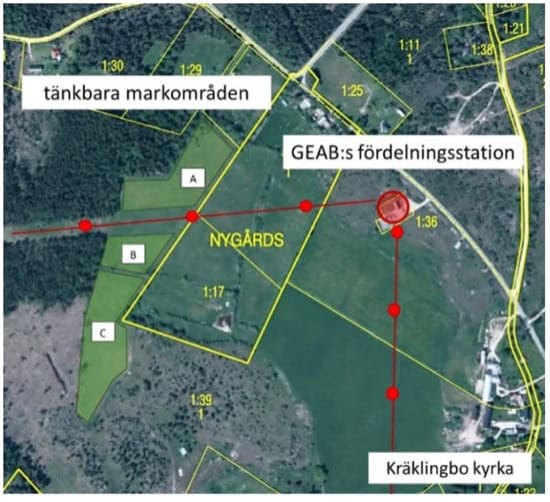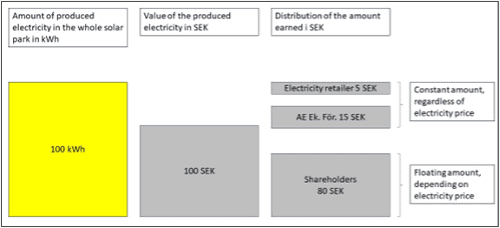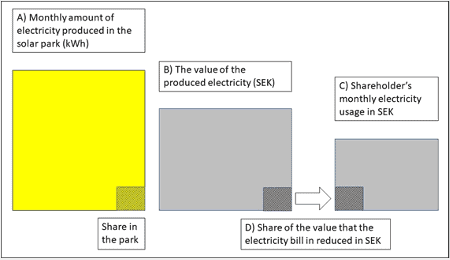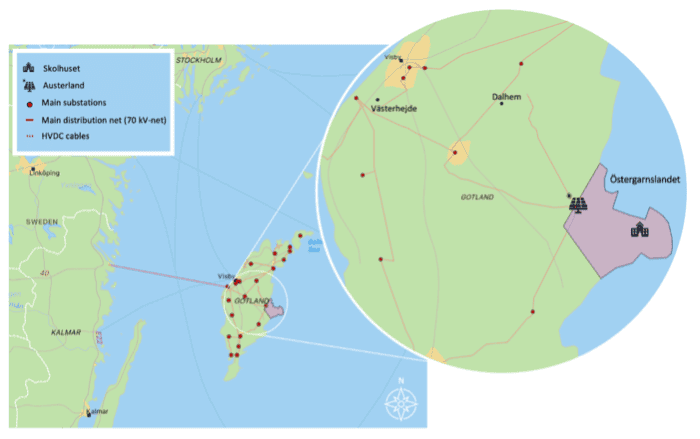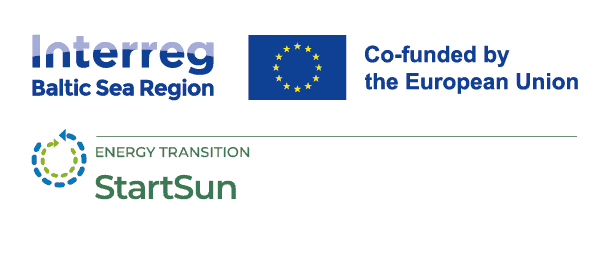
Case Study #7: Austerland Energi (Sweden)
08 October 2024
Author: CABÖ, Uppsala University
Keywords: Economic association, rural energy communities
Overview
Austerland Energi is a community energy initiative on the eastern side of Sweden’s largest island, Gotland, in the Baltic. The initiative started in 2018 and was formally organized as an energy community in 2023. The initiative is in Östergarnslandet[1], which is an area consisting of five rural parishes (“socken”) encompassing some 3700 households; one-third permanent residents and two-thirds second-home owners. Östergarnslandet is a sparsely populated area characterized by its agricultural and natural landscapes. Large parts of the land area are designated as environmental or cultural heritage protection areas or military safety zones.
The local development company Nygarn Utvecklingsbolag AB (a locally owned limited company) was the initiator for Austerland Energi. The energy community is primarily aimed at people living (full-time or seasonally) or working in Östergarnslandet (including private citizens, companies and organisations such as the local church), but in the energy community’s statues, there is also an opening for other people to join the community (after formal approval by the organization’s board).
Austerland Energi has a very well-developed design for how to organize a (rural) energy community – both to engaging community members and to formulate legal and economic structures for governing the community.
Legal form
In 2023, Austerland Energi formed a formal economic association, Austerland Energi Ekonomisk Förening, which they term an energy community or energigemenskap. The organisation also considered other organizational formats, mainly forming a limited company (aktiebolag in Swedish), but opted for an economic association as that was seen to be more inclusive and democratic in character, which is something that is sought after in the project. Historically, local energy initiatives akin to EUs energy communities have used different legal organizational formats in Sweden. This includes e.g. tenant-owned apartment association (bostadsrättsförening), non-profit organizations (ideell förening) and sole trader companies (enskild firma). However, the most common legal setup has been economic association.
When the EU’s clean energy package was implemented in Sweden, it was the Swedish Energy Market Inspectorate (Ei)[2] that was responsible for suggesting how it should be implemented. In 22020, they suggested that energy communities should be organized as economic associations (potentially as a special form of economic association) and that the communities should be delimited to a local geographic area. This suggestion meant in practice that no changes in the law were needed in relation to establishing an energy community in Sweden.
Regarding energy communities who want to share or sell electricity, Ei suggested that they should aim to do this in a virtual manner – unless the grid can be used in such a way that there is no need for grid concession (i.e. there is no need for a permit to connect to the grid, a so-called icke koncessionspliktigt nät, IKN). In 2022, a legal change was made that widened the scope for the type of electricity grid connections that do not need a permit. The change means that there is now a greater possibility to use the grid to share electricity between two properties without paying a fee.
No public entities are involved in the energy community at this point. However, the initiative has a lot of cooperation with the local public energy advisors.
Technological setup
At present, Austerland Energi has not installed any technologies for energy generation. However, a project is currently underway to install a solar park (1,5 MW on land area A and B in the figure). The solar panels will be built on the ground in a low productive agricultural area and the panels will be connected through one connection point to the existing electricity grid (the red line in the figure). The plan is to have the solar panels installed during 2024.
Austerland Energi has gotten an approval from the DSO to connect a generation unit up to 2.6 MW to the grid. However, not all the land that was planned for the park was approved for this by the regional authority, the County Administrative Board (specifically, area C was not approved). The plan is thus to start by installing 1,3 MW while continuing to investigate if further solar panels can be added later.
Although Austerland Energi currently is very focused on the solar park, the organization has investigated the possibility of utilizing many other technologies. In a pre-study from 2019, the focus was on exploring the potential for the whole Östergarndslandet to produce renewable energy (including solar, wind and biofuels), biochar production, energy storage and “smart electricity grids” (Brunner, 2019). In a feasibility study from 2023, the organization studied a delimited geographical area on Östergarnslandet in more detail, including possibilities for solar panels on an irrigation dam, wind turbines, hydrogen production, batteries, EV-charging, electrically charged trucks and agricultural machines, as well as smart ways to control and manage the local electricity grid and the devices potentially connected to it.
Maintenance and efficiency
In the statutes for the economic association, Austerland Energi Ekonomisk Förening, it is mentioned that the organisation should work towards increasing information and knowledge about sustainable energy consumption. In practice, joint procurement of smart meters that can be connected to the community’s possible future electricity-sharing system has been discussed, but there are no plans to implement that at present. The idea here is that smart meters can provide flexible services and energy savings.
Governance
The economic association that has been set up as the formal organisational form for the energy community, i.e. Austerland Energi Ekonomisk Förening, is governed according to the normal structure for economic associations in Sweden. The association has statutes4 that steer the scope of the association’s activities, memberships (inclusion and exits), scale of investments in the association, governance roles, responsibilities and activities, how surplus from the organization should be distributed, as well as the procedure for possible disputes or resolutions of the association.
Once a year, all members of the economic association are invited to a general meeting where they decide on the overall direction for the upcoming year’s activities and elect a board for the same period. Each member of the association has one vote during the general meeting. The board consists of a chairman and five to nine other board members (plus max nine alternates). They will be in-charge of running activities (possibly including practical duties such as technical maintenance) and making decisions on a day-to-day basis. The association can also choose to hire people to do specific activities, e.g. maintenance work.
To become a member of an economic association a person (a physical or legal person) needs to have an electricity supply contract with the local electricity company, GEAB, and ideally have their electricity subscription connected to a location on
Östergarnslandet (i.e. the membership is personal and follows the electricity contract supply address – not e.g. the property). The statute also allows for an actor outside of Östergarnslandet to be part of the association, but in those cases the board needs to make a special decision to grant membership. To become a full member, one needs to pay a yearly membership fee (currently 200 SEK/approx. 18 euro), sign an agreement with the association to buy electricity, as well as make an investment of between 8-15 000 SEK for every 1 kW from the association’s future solar park that the member has entered into contract to buy electricity from (currently the estimated cost for the planned solar park is 11 000 SEK or 980 euro/installed 1 kW).
A member is free to hand over their share to another person. However, the new shareholder needs to become a member of the association in the same way as has been described above (if not, the new shareholder will lose their share(s), which will go back to the association to manage). A member can also decide to leave the association. This is done in writing and comes into effect at the end of the fiscal year.
Business model
The solar park that Austerland Energi is currently in the process of building will be funded through investments from members in the economic association (i.e. without any public funding). Almost 200 actors (private individuals, companies and organisations) had expressed an interest in investing in the solar park and declared a combined investment will of more than 9 million SEK.
There are currently no plans to include public investment in the solar park. However, the different pre-studies and feasibility studies done by the Austerland Energi initiative have gotten public funding. This includes LEADER funds as well as funds from the Swedish Agency for Economic and Regional Growth’s regional fund.
The electricity from the planned solar park will be sold to the local electricity retailer, GEAB, and the consumers of the electricity all have chosen to buy electricity from this company (including members of the economic association as this is a prerequisite to become a member of the association).
The profit from the electricity that the association sells to GEAB will be distributed between a) GEAB (to cover their administrative costs), b) the economic association (to pay for operation and maintenance costs) and c) the members based on their invested share in the solar park (see figure below). The amount going to the GAB and the economic association is said to be the same every year, while the amount to the members will be dependent on the amount of produced electricity and electricity price.
The profit paid to the shareholders will primarily be paid through their electricity bill. Here GEAB will deduct the shareholders’ profits from the electricity produced in the solar park from the bill for their privately used electricity (Austerland Energi 2023). In practice this means that A) GEAB measures the total amount of electricity produced by the solar park and B) determines the monthly value of this based on the spot price for electricity. In the next step, C) the shareholder’s monthly electricity usage and their share in the solar park is measured, and then D) an electricity bill is sent to the shareholder where the value of the share of electricity from the solar park is deducted from the bill (see figure below).
Electricity bills in Sweden include four different parts: the fee for the electricity supply contract (abonnemangsavgift), a fee for the use of the electricity grid (elöverföringsavgift), energy tax and a fee for the electricity you have bought (elhandelsavgift). As a shareholder, the three first parts will remain the same, while the fourth part is where the deduction of one’s profit from the solar park electricity will be made.
Austerland Energi (2023) have made a comparison between the current differences between building one’s own solar panels and being a shareholder in their economic association which highlights how the different taxes, fees and subsidies in Sweden are implemented. If a person builds solar panels on one’s own house, there will be less electricity delivered to this house, which means that the energy tax and the fee for grid usage also will be lowered. The person can also get “green electricity tax deductions” for any electricity sold to the electricity retailer and (sometimes) a “green tax deduction” for the actual investment. When you become a shareholder in the economic association, you will not reduce your actual consumption of electricity in any way, which means that it is neither possible to lower the energy tax or the electricity grid fee, nor to be eligible for the green electricity tax deduction or the green tax deduction for investments. However, by investing in a solar park as a member of an economic association, you will be able to share responsibility for planning, operation and maintenance of the solar panels.
Digital tools
At present, there will be no specific local energy management system installed in connection to the energy community. The billing is planned to be handled by the local electricity retailer. The data is collected from the electricity contract meter of the solar park as well as from the electricity meters that each member is connected to (having such a connection is a prerequisite for becoming a member). As this setup uses the data management technology that the electricity retailer has been using for a long time, the data privacy should remain the same as before.
In Austerland Energi’s feasibility studies, there have been ideas about installing smart meters for interested energy community members, so this could be a possible next step for the community. The initiative has also investigated a few other technologies that could be added to the local energy system, however, there are currently no concrete plans for anything else but the solar park.
Social inclusion
Building on extensive experience with cooperative local development projects (including development of broadband access and building a local water plant), the Austerland Energi initiative was founded for engaging people from the local area in the energy transition. No specific effort has been made to engage a specific subset of the community – everyone in the community (including fulltime residents and second homeowners as well as farmers, local companies and organisations) is invited to join. To date, the people who have expressed an interest to join seem to have a slight overrepresentation of “older people” (the area generally has an ageing population) and second homeowners.
Regarding gender representation, the project development team is mostly made up by men, but among those who are interested to join the community men and women have equal representation (Mundbjerg & Bredkjær Thomsen, 2023).
A lot of effort has gone into trying to include the community in the process of developing the energy community. To this end, the initiative has developed a lot of informational material, including a webpage and brochures as well as professionally developed information videos and photography. The project developers also continuously arrange public meetings (both in person and online) where people are invited to hear about the updates from the project as well as give input to its continued development. Two surveys have also been sent out (online and through the mail) to the community with the intention to both inform about the project and to take inventory of the local interest for the initiative, as well as to get an idea of what the local energy use and needs look like. Information about the project has furthermore reached a wider audience, regionally and nationally, through newspaper articles, webinars, television and radio, where the project developers have presented and discussed the project.
The story of Austerland Energi in English can also be found here: Nordregio Projects. “Locally Owned Energy Cases.”
References
Energimarknadsinspektionen. 2023. “EI in English.” Energimarknadsinspektionen. https://ei.se/ei-in-english.
Gotlands Energi. 2023. Gotlands Energi. https://gotlandsenergi.se/.
Larsson, D. 2023. “Genomförbarhetsstudie Austerland Skags.” Austerland Energi. https://austerlandenergi.se/wp-content/uploads/Slutrapport-Austerland-Skags.pdf.
Mundbjerg, F. M., and M. Bredkjær Thomsen. 2023. “(Em)powering Community Energy on Gotland: An Exploration of Energy Justice through a Case Study of ‘An Island in an Island’.” Master Thesis Series in Environmental Studies and Sustainability Science, No. 2023:032. https://lup.lub.lu.se/luur/download?func=downloadFile&recordOId=9120318&fileOId=9120326.
Wikipedia. 2023. “Östergarns Socken.” Wikipedia, the Free Encyclopedia. https://sv.wikipedia.org/wiki/Östergarns_socken.
